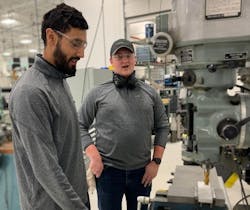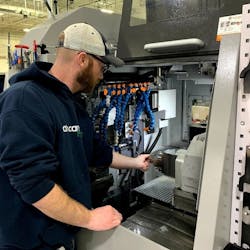A New Model of Employment? Work First, Then Earn Degree
Autocam Medical looked into the future, back in 2016, and saw there was a big problem.
“If we didn’t start working on our talent pipeline, we were going to be in trouble,” says John Kennedy, IV, General Manager of Autocam Medical, a contract manufacturer of precision, surgical and medical components and devices based in Kentwood, Michigan. The company also has plants in Massachusetts, Tennessee, China and Brazil.
“We were looking at the age of the workforce and realized that due to retirement we would have a large number of employees all starting around the same time, so we decided we needed to create a pathway and pipeline for some of that knowledge sharing process,” Kennedy added.
The skilled labor shortage is not a secret. By 2024, there are expected to be 811,000 openings in the professional trades industry. At the same time, the company is facing retirement issues, it is also growing. Over the past five years, the company has both doubled in revenue and employment. In June of 2021, Autocam Medical announced that they will build a 100,000 square-foot manufacturing facility and global headquarters at their Kentwood location. The addition will support 250 new jobs.
Earn and Learn Model
To attract new talent the company offers an apprenticeship program using an earn and learn model. “The goal is to bring students with high school or equivalent education into the company and have them earn journeyman’s cards while working,” says Kennedy. “They can continue on to earn an associate degree, engineering degree, or other advanced degrees. It’s just a different pathway than getting a degree first and then finding a job,” said Kennedy.
The company’s apprenticeship program provides students with a full-time job in CNC machining. At the same time, the company pays 100% of students’ college tuition as they earn a CNC certificate. The course of study also covers Michigan’s requirements for a journeyman’s card and puts apprentices on the path to receive a college degree, earning 27 credits. The year-round program requires students to complete over 700 hours of classroom instruction over a period of 90 weeks.
The company’s long-standing partnership with Grand Rapids Community College, Grand Valley State University, Ferris State University and Western Michigan University, gives students access to degrees. Autocam also played an integral role in the creation of the Advanced Manufacturing Partnership (AMP) Lab at Western Michigan University. The company outfitted the 15,000 square-foot manufacturing incubator with the high-tech equipment needed to develop and evaluate new products and prototypes.
Sourcing Talent
To find students for the program, Autocam has taken a multi-prong approach. They work with area schools to educate students as young as middle school about what the industry does. They support AMP camps for this grade to expose them to the equipment and processes and creative end of manufacturing. They work with area high schools, bringing students into the factory for tours. And they reach out to the community in general through their recent participation in a STEM booth that was part of the Grand Rapid’s ArtPrize celebration.
“We need to reach parents as well as students and attending a community-wide program such as ArtPrize gives us an opportunity to engage with parents,” says Kennedy. “The sector still faces an of misconceptions, even after we have been pushing hard to educate people about the current state of the industry which is high tech,” Kennedy tells the story of a parent who approached him at a job fair and said that while he had worked in manufacturing and he knows it has changed, he still felt it hasn’t changed enough for him to encourage his children to work in the field.
Changing Perceptions
The need to educate both parents and students about the current state of manufacturing factories and the advantage of building a career in the industry is an ongoing effort by the entire community. Part of the change, says Kennedy, is the need to view education and the definition of success differently. “In so many places success has been viewed as earning a four-year degree before entering the workforce but success can look different. You can enter the workforce, get paid, and earn the degree, it’s just a different order and I think there is a lot of value to be gained from earning the degree while someone is working,” says Kennedy.
While it is taking students longer to earn the degree, six or seven years instead of four, says Kennedy, the retention rate is high, so employees seem to like this path. He notes that the retention rate is especially high for those who earn their journeyman’s card or associated degree.
“There is no requirement that students stay with us after they earn their degrees, so this is really natural retention. We believe that part of that is because we provide a great place where they want to work.”

